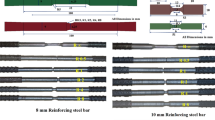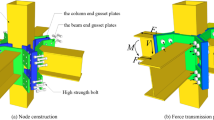Abstract
The purpose of this paper is to propose an analytical model for a new type of steel cushion for use in Reinforced Concrete (RC) frames. Theoretically, steel cushions were installed in the RC frame between a beam and chevron-type bracing elements to dissipate a considerable amount of energy during earthquake events. The cyclic shear behaviours of the steel cushions were experimentally determined by performing quasi-static tests. The results of these tests served as the main basis for a simplified hysteretic model that was proposed for the steel cushions. An analytical model was developed for an RC frame that represents low-rise structures. The analytical models of the steel cushions and the RC frame were superimposed. The effectiveness of the steel cushions was numerically assessed by performing a nonlinear static analysis of the frame instrumented with the steel cushion. The results of the numerical analysis indicate that the steel cushions contribute to the energy dissipation and damping properties of the RC frame. The strength of the instrumented frame was significantly higher than the strength of the bare frame. The proposed model is effective and practical for representing the contribution of the steel cushion to the total behaviour of the RC frame.
Similar content being viewed by others
References
Alehashem, S., M., S., Keyhani A., and Pourmohammad, H. (2008). “Behavior and performance of structures equipped With ADAS & TADAS Dampers (a Comparison with Conventional Structures).” The 14th World Conference on Earthquake Engineering, Beijing, China.
Bergman, D. M. and Goel, S. C. (1987). Evaluation of cyclic testing of steel-plate devices for added damping and stiffness, Report UMCE 87-10, Univ. of Michigan, Ann Arbor.
Chan, R. W. K., Albermani, F., and Williams, M. S. (2009). “Evaluation of yielding shear panel device for passive energy dissipation.” Journal of Constructional Steel Research, Vol. 65, pp. 260–268, DOI: 10.1016/j.jcsr.2008.03.017.
Chopra, A. K. (2007). “Dynamics of structures: Theory and application to earthquake engineering.” 2nd edition, Prentice Hall of India.
Federal Emergency Management Agency (2007). Interim Testing Protocols for Determining the Seismic Performance Characteristics of Structural and Nonstructural Components, FEMA Report 461, Washington
Gray, M. G., Christopoulos, C., and Packer, J. A. (2010). “Cast steel yielding fuse for concentrically braced frames.” Proceedings of the 9th U.S National and 10th Canadian Conference on Earthquake Engineering, Toronto, Ontario, Canada pp. 595.
Güllü, A., Özkaynak, H., Khajehdeh, A., Gökçe, T., Azizisales, F., Bal, İ. E., Smyrou, E., Yüksel, E., Karadoğan, H. F. (2015). “Derivation of the closed form equations for the energy dissipative steel cushions,” 14th World Conference on Seismic Isolation, Energy Dissipation and Active Control of Structures (14WCSI), San Diego, CA., USA, 9-11 September.
Habibi, A., Chan, R. W. K., and Albermani, F. (2013) “Energy-based design method for seismic retrofitting with passive energy dissipation systems.” Engineering Structures No. 46, pp. 77–86, DOI: 10.1016/j.engstruct.2012.07.011.
Iwata, M., Kato, T., and Wada, A. (2000). “Buckling-restrained braces as hysteretic dampers.” Behavior of Steel Structures in Seismic Areas, Proceedings of the 3rd International Conference STESSA 2000, Mazzolani, F., and Tremblay, R. (ed.), Montreal, Canada, August 21-24, pp. 33–38.
Kelly, J. M., Skinner, R. I., and Heine, A. J. (1972). “Mechanisms of energy absorption in special devices for use in earthquake resistant structures.” Bulletin of New Zealand Society for Earthquake Engineering, Vol. 5, No. 3), pp. 63–68.
Kim, J. and Choi, H. (2004). “Behavior and design of structures with buckling-restrained braces.” Engineering Structures, Vol. 26. pp. 693–706.
Martinez-Rueda, J. E. and Elnashai, A. S. (1997). “Confined concrete model under cyclic load.” Materials and Structures, Vol. 30, No. 3), pp. 139–147, DOI: 10.1007/BF02486385.
Menegotto, M. and Pinto, P. E. (1973). “Method of analysis for cyclically loaded R.C. plane frames including changes in geometry and non-elastic behaviour of elements under combined normal force and bending.” Symposium on the Resistance and Ultimate Deformability of Structures Acted on by Well Defined Repeated Loads, International Association for Bridge and Structural Engineering, Zurich, Switzerland, pp. 15–22.
Maleki, S. and Bagheri, S. (2010). “Pipe damper, Part I. Experimental and analytical study.” Journal of Constructional Steel Research, Vol. 66, Nos. 8-9, pp. 1088–1095, DOI: 10.1016/j.jcsr.2010.03.010.
Maleki, S. and Mahjoubi, S. (2013). “Dual-pipe damper.” Journal of Constructional Steel Research, Vol. 85, pp. 81–91.
Maleki, S. and Mahjoubi, S. (2014). “Infilled-pipe damper.” Journal of Constructional Steel Research, Vol. 98, pp. 45–58.
Mander, J. B., Priestley, M. J. N., and Park, R. (1988). “Theoretical stress-strain model for confined concrete.” Journal of Structural Engineering, Vol. 114, No. 8), pp. 1804–1826, DOI: 10.1061/(ASCE)0733-9445(1988)114:8(1804).
Mahjoubi, S. and Maleki, S. (2015). “Seismic performance assessment of steel frames equipped with a novel passive damper using a new damper performance index.” Structural Control and Health Monitoring, Vol. 22, No. 4), pp. 774–797.
Nakashima, M., Iwai, S., Iwata, M., Takeuchi, T., Konomi, S., Akazawa, T., and Saburi, K. (1994). “Energy dissipation behaviors of shear panels made of low yield steel.” Earthquake Engineering and Structural Dynamics, Vol. 23, pp. 1299–1313.
Oh, S. H., Kim, Y. J., and Ryu, H. S. (2009). “Seismic performance of steel structures with slit dampers” Engineering Structures, Vol. 31, pp. 1997–2008, DOI: 10.1016/j.engstruct.2009.03.003.
Ozkaynak, H., Gullu, A., Gokse, T., Khajehdei, A., Mahdavi, M., Azizisales, F., Smyrou, E., Bal, I. E., Yuksel, E., and Karadogan, F. (2014) “Energy dissipater steel cushions” 2nd European Conference on Earthquake Engineering and Seismology, Istanbul, TURKEY.
Özkaynak, H., Güllü, A., Khajehdehi, A., Gökçe, T., Azizisales, F., Bal, I. E., Smyrou, E., Yüksel, E., and Karadogan, F. (2015). “Bidirectional loading tests of steel cushions” 14th World Conference on Seismic Isolation, Energy Dissipation and Active Vibration Control of Structures (14WCSI) 9-11 September 2015, San Diego, California, USA.
Priestley, M. J. N. (1991). “Overview of PRESSS research program.” Journal of Precast Concrete Institute, Vol. 36, No. 4), pp. 50–57.
Rai, D. C., Annam, P. K., and Pradhan, T. (2013) “Seismic testing of steel braced frames with aluminum shear yielding dampers.” Engineering Structures, Vol. 46, pp. 737–747, DOI: 10.1016/j.engstruct.2012.08.027.
Ramberg, W. and Osgood, W. R. (1943). “Description of stress-strain curves by three parameters.” National Advisory Committee on Aeronautics, Technical Note 902.
Sahoo, D. R. and Rai, D. C. (2009). “Seismic strengthening of nonductile reinforced concrete frames using aluminum shear links as energy-dissipation devices.” Engineering Structures, Vol. 32, pp. 3548–3557, DOI:10.1016/j.engstruct.2010.07.023.
Skinner, R. I., Kelly, J. M., and Heine, A. J. (1975). “Hysteresis dampers for earthquake-resistant structures.” Earthquake Engineering and Structural Dynamics, Vol. 3, No. 3), pp. 287–296, DOI: 10.1002/eqe.4290030307.
Shultz, A. E. and Magana, R. A. (1996). “Seismic behavior of connections in precast concrete walls.” Proceedings of Mete A. Sozen Symposium, ACI SP162, American Concrete Institute, Farmington Hills, Mich, pp. 273–311.
SAFECLADDING EUProject (2012-2015). Improved Fastening Systems of Cladding Panels for Pre-cast Buildings in Seismic Zones.
SeismoSoft (2012). Seismostruct -A Computer Programme for Static and Dynamic Nonlinear Analysis of Framed Structures, Available from URL: http://www.seismosoft.com.
Tagawa, H. and Gao, J. (2012). “Evaluation of vibration control system with U-dampers based on quasi-linear motion mechanism.” Journal of Constructional Steel Research, Vol. 70, pp. 213–25.
Tsai, K. C., Chen, H. W., Hong, C. P., and Su, Y. F. (1993). “Design of steel triangular plate energy absorbers for seismic resistant construction.” Earthquake Spectra, Vol. 9, No. 3), pp. 505–528, DOI: 10.1193/1.1585727.
Taskin, K. (2011). Betonarme Çerçevelerin Özel Köşe Çaprazlari İle Güçlendirilmesi, PhD Thesis, Istanbul Technical University, Istanbul, Turkey.
Valente, M. (2013). “Seismic protection of R/C Structures by a new dissipative bracing system.” The 2nd International Conference on Rehabilitation and Maintenance in Civil Engineering Procedia Engineering Vol. 54, pp. 785–794, DOI: 10.1016/j.proeng.2013. 03.072.
Whittaker, A. S., Bertero, V. V., Thompson, C. I., and Alsonson, L. J. (1991). “Seismic testing of steel plate energy dissipation devices.” Earthquake Spectra, Vol. 7, No. 4), pp. 563–604, DOI: 10.1193/1.1585644.
Xia, C. and Hanson, R. (1992). “Influence of ADAS element parameters on building seismic response.” Journal of Structural Engineering, Vol. 118, No. 7), pp. 1903–1918.
Author information
Authors and Affiliations
Corresponding author
Rights and permissions
About this article
Cite this article
Özkaynak, H. Model proposal for steel cushions for use in Reinforced Concrete frames. KSCE J Civ Eng 21, 2717–2727 (2017). https://doi.org/10.1007/s12205-017-0477-1
Received:
Revised:
Accepted:
Published:
Issue Date:
DOI: https://doi.org/10.1007/s12205-017-0477-1




